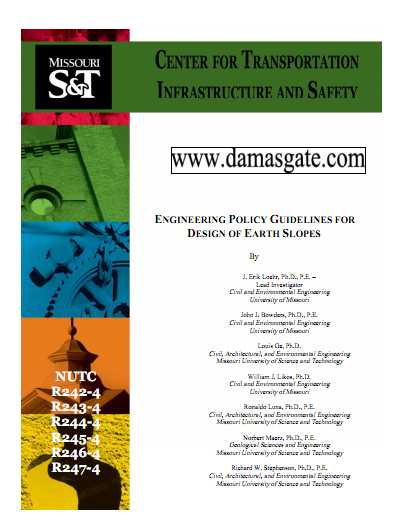Engineering Policy Guidelines for Design of Earth Slopes

Preface
These guidelines were developed as part of a comprehensive research program undertaken by the Missouri Department of Transportation (MoDOT) to reduce costs associated with design and construction of bridge foundations and earth slopes while maintaining appropriate levels of safety for the traveling public. The research program included four broad tasks:
- Task 1 – evaluation of site characterization methods for use in Load and Resistance Factor Design (LRFD) and development of procedures to quantify variability and uncertainty in soil/rock properties,
- Task 2 – evaluation of foundation design methods and completion of a foundation load testing program to improve foundation design,
- Task 3 – evaluation of costs and risks for different LRFD limit states and establishment of appropriate target reliabilities for different classes of roadways/structures, and
- Task 4 – calibration of MoDOT specific resistance factors for design of bridge foundations and earth slopes and development of design guidelines to provide means for implementing the results of the research program.
The research program was conducted by faculty, students, and staff from the University of Missouri and Missouri University of Science and Technology in collaboration with MoDOT personnel and private industry. The research program was completed in Fall 2010. These guidelines, along with several others, serve as the principal deliverables from the research program.
The guidelines were established from a combination of existing MoDOT Engineering Policy Guide (EPG)
Edition of the AASHTO LRFD Bridge Design Specifications with 2009 Interim Revisions, and from results of the research program. Some provisions of the guidelines represent substantial changes to current practice to reflect advancements made possible from results of the research program. Other provisions were left essentially unchanged, or were revised to reflect incremental changes in practice, because research was not performed to address those provisions. Some provisions reflect rational starting points based on judgment and past experience from which further improvements can be based. All of the provisions should be considered as “living documents” subject to further revision and refinement as additional knowledge and experience is gained with the respective provisions. A number of specific opportunities for improvement are provided in the commentary that accompanies the guidelines.
documents, from the 4th
Download
http://s18.alxa.net/s18/srvs2/01/Eng...rth.Slopes.rar